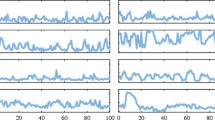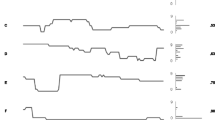Summary
The repetitious measurement of actual mood alterations becomes more and more common in research oriented psychiatric departments. In this article a new method for the mathematical description and statistical evaluation of time series data is presented. This computerized approach is less restrictive than other procedures and seems to be very appropriate to the complex structure of time series. First results on mood courses of depressive and schizophrenic patients are presented to demonstrate the usefulness and validity of this new method.
Similar content being viewed by others
References
Box GEP, Jenkins GM (1976) Time series analysis: forecasting and control (revised edn). Holden-Day, San Francisco
Everitt B (1974) Cluster analysis. Heinemann, London
Hirsch SR (1983) The causality of depression in schizophrenia. Br J Psychiatry 142:624–625
Kleiter EF (1985) HTAKA. Hierarchische Trend-Abschnitt-Komponenten-Analyse. Ein Verfahren zur Analyse von Zeitreihen. EDV-Programm innerhalb des Programm-Systems KMFF. Eigenverlag, Kiel
Luria RE (1975) The validity and reliability of the visual analogue mood scale. J Psychiatr Res 12:51–57
Möller HJ, Zerssen D von (1981 a) Depressive Symptomatik bei Aufnahme und Entlassung stationär behandelter schizophrener Patienten. Nervenarzt 52:525–530
Möller HJ, Zerssen D von (1981b) Depressive Symptomatik im stationären Behandlungsverlauf von 280 schizophrenen Patienten. Pharmacopsychiatry 14:172–179
Möller HJ, Zerssen D von (1982) Depressive states occurring during the neuroleptic treatment of schizophrenia. Schizophrenia Bull 8:109–117
Möller HJ, Barthelmes H, Zerssen D von (1983) Forschungsmöglichkeiten auf der Grundlage einer routinemäßig durchgeführten psychiatrischen Basis- and Befunddokumentation. Psychiatria Clin 16:45–61
Möler HJ, Kissling W, Kuß HJ (1984) Kann die zusätzliche Gabe von Haloperidol die Wirksamkeit von Antidepressiva verbessern? Ergebnisse einer Doppelblindstudie über Chlorimipramin. In: Hopf A, Beckmann H (Hrsg) Forschungen zur biologischen Psychiatrie. Springer, Berlin Heidelberg NewYork, pp 295–298
Prusoff BA, Klerman G, Paykel E (1972) Concordance between clinical assessment and patient self-report in depression. Arch Gen Psychiatry 26:546–552
Strian F, Albert W, Klicpera C (1979) Course of depressive mood and psychomotor activation in endogenous depression. Arch Psychiatr Nervenkr 227:193–206
Strian F, Albert W, Klicpera C (1979) Antidepressive treatment and mood swing patterns in endogenous depression. Pharmacopsychiatry 12:432–437
Strian F, Heger R, Klicpera C (1982) The time structure of depressive mood in schizophrenic patients. Acta Psychiatr Scand 65:66–73
Zerssen D von (1976) Klinische Selbstbeurteilungs-Skalen (KSb-S) aus dem Münchner Psychiatrischen Informationssystem (PSYCHIS Mfinchen). Manuale: (a) Allgemeiner Teil, (b) Paranoid-Depressivitäts-Skala, (c) Befindlichkeits-Skala, (d) Beschwerden-Liste. Beltz, Weinheim
Zerssen D von (1986) Clinical self-rating scales (CSRS) of the Munich psychiatric information system (PSYCHIS München). In: Sartorius N, Ban TA (eds) Assessment of depression. Springer, Berlin Heidelberg NewYork Tokyo, pp 270–303
Author information
Authors and Affiliations
Additional information
Dedicated to Professor D. von Zerssen to his 60th birthday
Rights and permissions
About this article
Cite this article
Möller, H.J., Leitner, M. & Dietzfelbinger, T. A linear mathematical model for computerized analyses of mood curves. Eur Arch Psychiatr Neurol Sci 236, 260–268 (1987). https://doi.org/10.1007/BF00380950
Received:
Issue Date:
DOI: https://doi.org/10.1007/BF00380950




